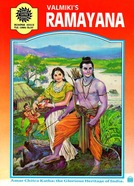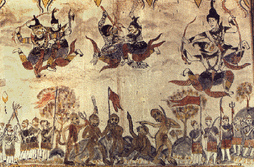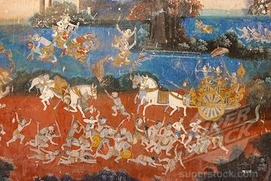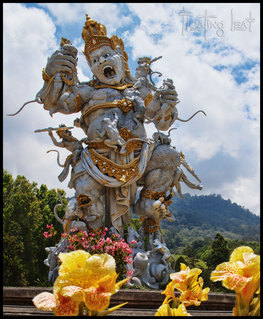what's the ramayana?

The Ramayana is a love story with universal themes such as loyalty, and good versus evil. It is also one of ancient India's major Sanskrit epics and is sometimes referred to as the sister-tale of the Mahabharata.
In this famous epic, the main characters, Rama and Sita, are lovers. When Sita was captured by the evil king Ravana, Rama called on an army of animals, led by Hanuman the Monkey King, to save her. After she was rescued, he then demanded she prove her purity before he could take her back as his wife, in order to set a good example.
In this famous epic, the main characters, Rama and Sita, are lovers. When Sita was captured by the evil king Ravana, Rama called on an army of animals, led by Hanuman the Monkey King, to save her. After she was rescued, he then demanded she prove her purity before he could take her back as his wife, in order to set a good example.
The ramayana's influence on southeast asia
Like the Mahabharata, the Ramayana was brought to the region and has influenced Southeast Asia in many ways. This was due in part to the fact that the story's universal themes appealed to the local people, and was hence adopted by them.
Firstly, many national epics of Southeast Asia were derived from the Ramayana. Examples include the Ramakien from Thailand, Phra Lak Phra Lam from Laos, and Reamker from Cambodia. This shows the Ramayana's strong influence over literature in many large Southeast Asian countries as so many different national epics were based on this one story.
Furthermore, many traditional dances in the region are also based on this Indian epic. For example, the Kecak dance from Bali is about the battle between Rama, helped by Hanuman, and the evil king Ravana. Also, a genre of dance-drama from Thailand called Khon is based on the Ramakien. All this indicates the presence of the Ramayana's impact on dance in the region.
There are also many sculptures of characters or scenes from the Ramayana present in Southeast Asia today. This is evidenced by the Statue of Hanuman in Bali, and the many bas-relief depictions of the story in Angkor Wat, clearly showing its influence.
In addition, the Ramayana has also played a part in shaping the traditional practices of Southeast Asian societies. For instance, the Balinese celebrate elaborate Hindu festivals, an example of which is Diwali, based on the Ramayana.
All this evidence points to the Ramayana having a deep and lasting influence over the society and culture of Southeast Asia.
Firstly, many national epics of Southeast Asia were derived from the Ramayana. Examples include the Ramakien from Thailand, Phra Lak Phra Lam from Laos, and Reamker from Cambodia. This shows the Ramayana's strong influence over literature in many large Southeast Asian countries as so many different national epics were based on this one story.
Furthermore, many traditional dances in the region are also based on this Indian epic. For example, the Kecak dance from Bali is about the battle between Rama, helped by Hanuman, and the evil king Ravana. Also, a genre of dance-drama from Thailand called Khon is based on the Ramakien. All this indicates the presence of the Ramayana's impact on dance in the region.
There are also many sculptures of characters or scenes from the Ramayana present in Southeast Asia today. This is evidenced by the Statue of Hanuman in Bali, and the many bas-relief depictions of the story in Angkor Wat, clearly showing its influence.
In addition, the Ramayana has also played a part in shaping the traditional practices of Southeast Asian societies. For instance, the Balinese celebrate elaborate Hindu festivals, an example of which is Diwali, based on the Ramayana.
All this evidence points to the Ramayana having a deep and lasting influence over the society and culture of Southeast Asia.
National Epics derived from the Ramayana:
Sculptures and Bas-reliefs based on the Ramayana:
Kecak Dance Performance based on the Ramayana, about the entry of Hanuman:
Click here to continue.



